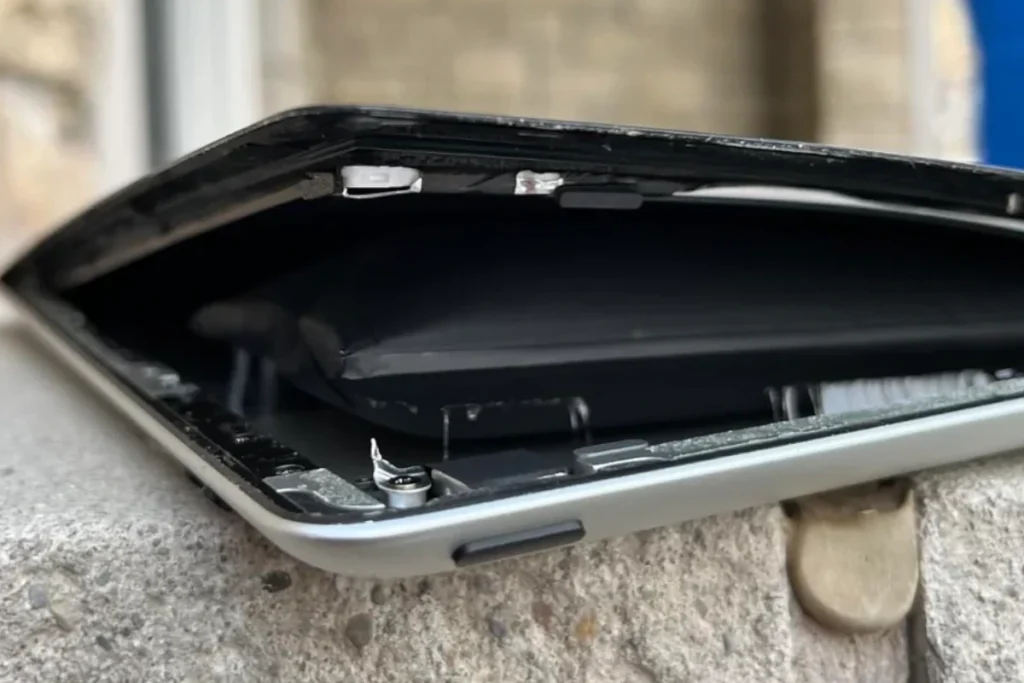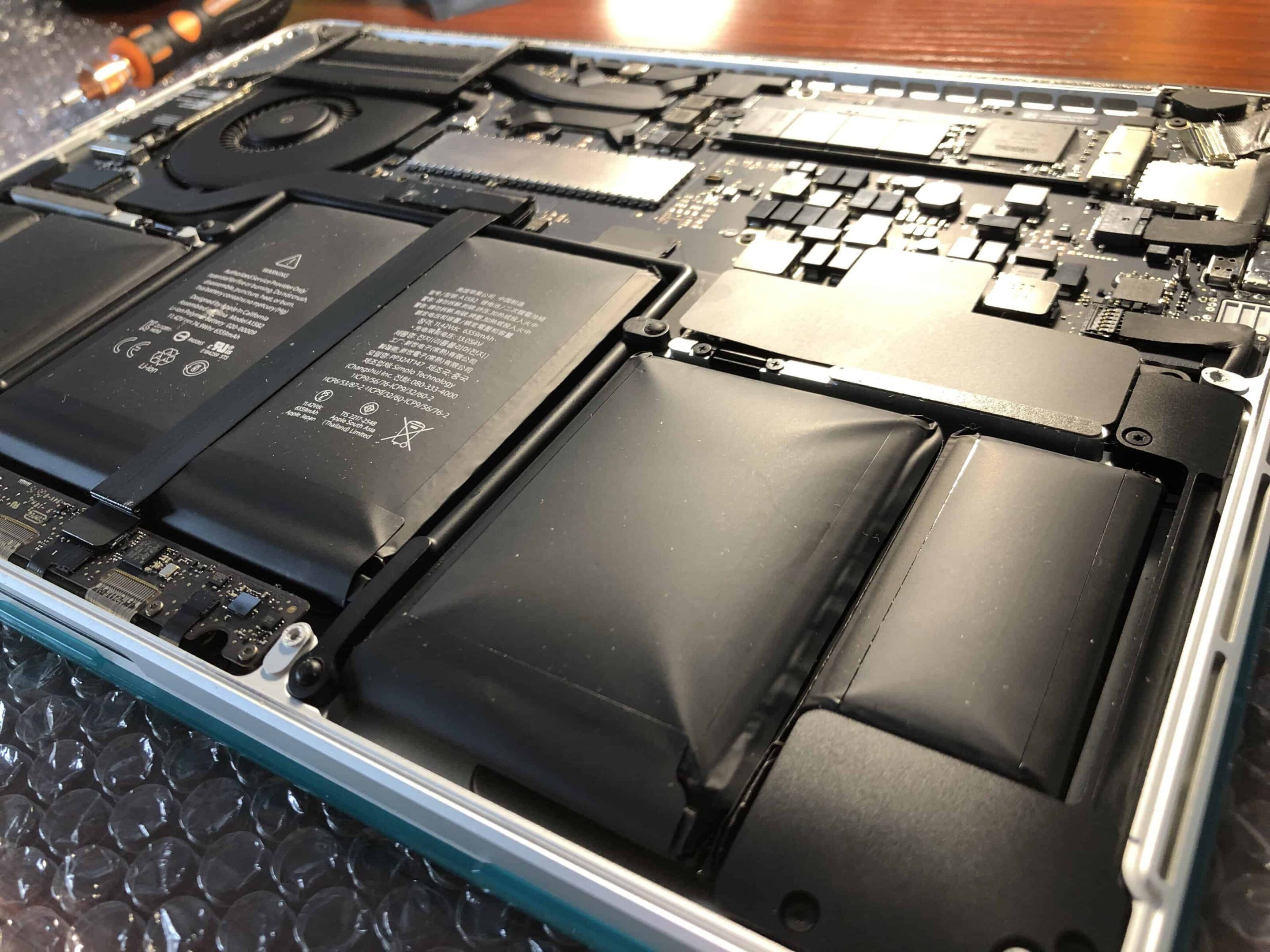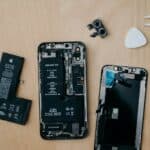If your device’s battery swells, it’s a serious safety risk. Swelling means the battery has a chemical imbalance, often from overcharging, damage, or aging. This can harm the battery’s cells and cause gas to build up inside. The swelling puts pressure on the battery, which could lead to a rupture or explosion. If a battery swells, it can damage or break the device. There’s a real risk of a swollen battery exploding because the pressure can cause the casing to rupture.
That’s why you need to act fast. Power off your devices, don’t charge them, and get professional help to remove and dispose of the battery. Using or charging a swollen battery increases the risk of fire or explosion. Have you noticed a bulge in your device’s battery? It could be swollen and dangerous. In this article, we’ll talk about the risks of swollen batteries, including explosions, and what you should do to stay safe and dispose of these hazardous components properly.
Understanding Swollen Battery Risks
What is a Swollen Battery?
A swollen battery is a lithium-ion battery that has expanded due to the buildup of gas inside. This can happen due to various reasons, such as overcharging, age, or manufacturing defects. The swelling can be minor, like a slight bulge, or severe, where the battery casing cracks open.
Can a Swollen Battery Explode?
Yes, a swollen battery can explode. The gas buildup inside creates pressure, and if this pressure exceeds the battery’s structural integrity, it can rupture or explode. The risk of explosion is higher if the battery is punctured, exposed to high temperatures, or continues to be used in a device.
Risks Associated with Swollen Batteries
- Fire Hazard: The chemicals inside a lithium-ion battery are flammable, and an explosion can ignite them, causing a fire.
- Chemical Burns: A ruptured battery can leak hazardous chemicals, causing skin and eye irritation or burns.
- Device Damage: A swollen battery can damage the device it’s in, deforming the casing and potentially affecting other components.
Precautions to Take
If you notice a swollen battery:
- Stop using the device immediately.
- Do not charge the device.
- Do not puncture or try to open the battery.
- Store the device in a cool, dry place away from flammable materials.
- Remove the battery if possible and dispose of it properly.
If you are unsure how to handle a swollen battery, consult a professional for assistance.
Signs of a Swollen Battery
- Bulging or deformation of the battery casing.
- The device doesn’t lie flat on a surface.
- The trackpad or keyboard of a laptop is lifted or uneven.
- The device becomes unusually hot.
- The device’s battery life decreases significantly.
Proper Disposal of Swollen Batteries
Swollen batteries should not be thrown in regular trash. Instead, take them to a battery recycling center or an authorized e-waste disposal facility.
Table: Swollen Battery Risks and Precautions
| Risk | Precautions |
|---|---|
| Explosion | Stop using the device, do not charge, do not puncture, store safely, dispose of properly |
| Fire | Keep away from flammable materials |
| Chemical Burns | Avoid contact with leaking chemicals |
| Device Damage | Remove the battery if possible |
| Environmental Hazard | Dispose of at a battery recycling center or e-waste facility |

Potential For A Swollen Battery To Explode
| Key Points | Explanation |
|---|---|
| Swollen Battery = Increased Risk | A swollen battery indicates internal damage or a chemical reaction producing gas. This buildup of pressure makes it far more likely to rupture or explode than a healthy battery. |
| Explosion is Possible, Not Guaranteed | While a swollen battery presents a significant safety hazard, immediate explosion is not inevitable. Factors like the severity of the damage, temperature, and external pressure influence the risk. |
| The Danger Lies in the Unexpected | The main concern is that you can’t predict when a swollen battery might finally fail. It could happen during use, charging, or just sitting idle, leading to potential fire or injury. |
| Prevention vs. Waiting | Proactive replacement of a swollen battery is vastly preferable to waiting for it to potentially explode. Even if it doesn’t explode, a swollen battery will severely impact device functionality. |
Important Actions
- Stop Using the Device: If you notice battery swelling, power down the device immediately and handle it with care.
- Don’t Attempt Self-Repair: Don’t puncture or try to deflate a swollen battery.
- Seek Professional Help: Take the device to a qualified repair shop for safe battery replacement.
Additional Notes
- Lithium-ion batteries: This type, found in most modern electronics, is particularly susceptible to swelling and potential explosions.
- Signs of a swollen battery: Bulging casing, difficulty closing the device, a warped screen.
Key Takeaways
- Swollen batteries are hazardous and can potentially explode if not addressed promptly.
- Battery swelling is a sign of chemical imbalance often due to overcharging or damage.
- Immediate action should be taken to power down and properly dispose of a swollen battery.
Understanding Swollen Batteries
Swollen batteries result from internal gas buildup, often caused by chemical reactions within the device. Identifying and addressing these is critical for safety and device longevity.
Causes of Battery Swelling
Swollen batteries arise from a few primary factors such as overcharging, heat exposure, and manufacturing defects. Overcharging leads to chemical instability, while heat can accelerate battery degradation. Manufacturing issues can also contribute to swelling.
Recognizing Swollen Batteries
You may notice a device with a swollen battery doesn’t fit properly in its case. If a phone or laptop feels wobbly or its keyboard is raised, these are signs. Look out for any unusual bulges or distortions.
Risks and Safety Measures
A swollen battery poses risks like fire or an explosion. Prioritize safety; wear gloves and goggles, and keep the device in a well-ventilated area away from flammables. Isolate the device if it shows signs of damage.
Proper Handling and Disposal
Never puncture a swollen battery as it can lead to smoke or fire. When it’s time to dispose of a swollen battery, do so at a recycling center equipped to handle them.
Prevention of Swelling in Batteries
To prevent battery swelling, avoid exposing your device to extreme temperatures or moisture. Use chargers that match the device’s specifications and avoid overcharging by unplugging once full.
Swelling in Different Battery Types
Batteries in smartphones and laptops, especially lithium-ion types, are prone to swelling due to their high energy density. They require careful handling, charging, and storage.
Charging and Usage Best Practices
Follow best practices for charging and usage. Use high-quality chargers, avoid deep discharges, and keep devices in a cool, dry environment to extend battery life.
Recognizing a Faulty Battery
If your tech is heating up unusually or having difficulty charging, these may be signs of a faulty battery. Decreased battery life and the device not holding a charge are also indicators.
When to Opt for Battery Replacement
Opt for battery replacement when you spot signs of physical damage or degradation. If the battery doesn’t charge well or seems much less efficient, it’s time for a new one.
Professional Repair and Maintenance
For battery issues beyond your comfort zone, such as a swollen battery, it’s wise to seek professional repair services. They have the tools and expertise to safely handle and replace the battery.
Technical Insights into Battery Degradation
Battery degradation is a complex process influenced by various factors. Understanding these factors can help in prolonging the life of a battery and preventing hazardous scenarios such as swelling, which may lead to an explosion if not addressed promptly.
Chemical and Physical Changes
Battery swelling indicates a serious internal issue often due to chemical reactions within the battery. When a battery charges and discharges, ions move between electrodes, which can lead to the production of gases if the chemical reactions are not properly managed. These gases can cause the battery to swell. Repeated cycles can break down the electrode materials and compromise the battery’s structural integrity, further degrading its ability to store and release energy effectively.
Impact of Environmental Conditions
Exposing batteries to high temperatures or extreme environmental conditions accelerates degradation. Factors like humidity, moisture, or using a battery in an environment that is not well-ventilated can also contribute to a faster decline in battery performance. For optimal battery life, users should store and operate batteries in a cool, dry environment.
Role of Manufacturing Quality
The quality of manufacturing can greatly affect battery life. Defects introduced during the production process may result in weaknesses in the battery, leading to faster degradation or even swelling under normal use. It is crucial to use a high-quality charger, ideally the one provided by the manufacturer, as third-party chargers may not adhere to the required specifications and can cause overcharging.
Battery Longevity and Cycle Life
Cycle life refers to the number of complete charge and discharge cycles a battery can undergo before its capacity falls to a certain percentage of its original capacity. High energy density and optimal cycle durations are key to long-lasting batteries. Avoiding deep discharge and keeping the battery charged within its recommended limits can help in maintaining good battery health over time.
Energy Storage and Self-Discharge
Without use, batteries lose charge over time through a process known as self-discharge. This natural phenomenon affects overall energy storage capacity. A quality charger can maintain the correct voltage without overcharging, which reduces the risks of self-discharge and prolongs shelf life. Proper maintenance, such as regular, partial discharges instead of full discharges, can also extend battery longevity.
Frequently Asked Questions
The questions below address common concerns and provide clear guidance for dealing with swollen batteries in various devices.
What are the risks of a swollen battery exploding?
A swollen battery indicates that it has been damaged and becomes unstable, increasing the risk of an explosion. The built-up gases within the battery can lead to rupture and potential ignition.
How long does a swollen battery typically last before it becomes hazardous?
The lifespan of a swollen battery before it becomes dangerous is unpredictable and it should be treated as hazardous immediately upon detection.
What precautions should be taken if a battery starts to swell?
Upon noticing swelling, turn the device off and disconnect it from any power sources. Avoid applying pressure to the battery, do not pierce it, and keep it away from flammable materials.
Should I attempt to charge a device with a swollen battery?
Do not attempt to charge a device with a swollen battery, as this can further destabilize the battery and increase the risk of explosion or fire.
What is the safe method for disposing of a swollen battery?
Swollen batteries should be taken to a professional or a battery disposal facility that can handle them safely. They should not be thrown in the trash or recycling bins used for other items.
Are there any immediate steps to take upon discovering a swollen battery to ensure safety?
If a swollen battery is discovered, power down the device, place it in a safe area away from combustibles, and contact a professional for removal and disposal. Do so promptly to minimize risk.





